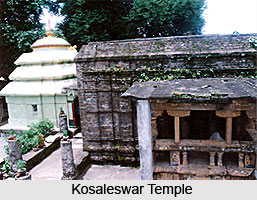 The Bhaum Kara dynasty of Utkala, during the first half of the 8th century, had come to power and had subdued the neighbouring kingdoms of Kangoda, Kalinga, Tosali and unified the whole territory of Orissa under one supreme command. They continued up to the middle of the 10th century. Though the Bhauma karas were Buddhists, they were extremely tolerant rulers, as a result other religious sects especially, Shaivism, continued to flourish in Orissa unhindered. They had deep reverence for Shaivism.
The Bhaum Kara dynasty of Utkala, during the first half of the 8th century, had come to power and had subdued the neighbouring kingdoms of Kangoda, Kalinga, Tosali and unified the whole territory of Orissa under one supreme command. They continued up to the middle of the 10th century. Though the Bhauma karas were Buddhists, they were extremely tolerant rulers, as a result other religious sects especially, Shaivism, continued to flourish in Orissa unhindered. They had deep reverence for Shaivism.
The Bhauma karas ruled for a period of 200 years and their rule is considered to be the golden epoch in the history of Orissa. The kings and queens of this dynasty built a large number of temples and monasteries throughout the length and breadth of their territory and even had cultural relations with far off countries like China. It is said that the Bhaumakara kings made huge land-grants to Brahmins noted for their Vedic learning.
Tribhubana Mahadevi, a queen of this dynasty was the daughter of a Naga ruler and a devout worshipper of Lord Vishnu, whereas her son Subhakara was a great patron of Shaivism. Madhavi Devi, the queen of Subhakara-I was a Shaivite and had built a temple of Lord Shiva and had installed the Madhaveswara Shiva after her name at Jaipur. It is believed that the early Bhaumakara rulers were Buddhists. However, the later rulers changed their faith to Shaivism. From the monuments of this period it is evident that both Shaivism and Tantrism prevailed in major parts of their country.
 A number of Shiva temples are assigned to this period. At Bhubaneshwar alone, there are ten such temples. The main members of this group are the Vaital, Markandeswar and Sisireswar. All these three temples have Nataraja images carved on the front facades within the medallions with borders of beads enclosed by the ornamented chaitya arches. There are other figures of dancers and dancing girls on the body of the temples. The sculptural representations of these images mark its identity with vigour, style and exuberance of the Buddhist art-tradition of the Bhauma culture.
A number of Shiva temples are assigned to this period. At Bhubaneshwar alone, there are ten such temples. The main members of this group are the Vaital, Markandeswar and Sisireswar. All these three temples have Nataraja images carved on the front facades within the medallions with borders of beads enclosed by the ornamented chaitya arches. There are other figures of dancers and dancing girls on the body of the temples. The sculptural representations of these images mark its identity with vigour, style and exuberance of the Buddhist art-tradition of the Bhauma culture.
The Shiva Temple at Ganja in Ganjam District, the Bhingeswar temple of Parshurameswar style at Bajrakot near Talcher on the right bank of Brahmani; the temple of Koalo in Dhenkanal District; the Kosaleswar temple at Baidyanath on Tel River at Sonerpur, in the Bolangir District; the twin temples of Nilamadhava Temple and Sidheswara Shiva at Gandharadhi in Boudh; the Sinhanatha Temple of Shiva in Baramba; the Grameswar temple of Athagarh and many other detached sculptures and architectural fragments present varied forms of Nataraja images and innumerable dancing figures of both males and females to testify the prevalence of the Shaiva school of dancing.
Hence it is evident that the Bhauma Kara rulers had abundant cultural influence in the state of Orissa and various forms of art including dance and music bears close resemblance with the Bhauma-Kara way of life.



















